
Goal setting can be applied in any area of life. Whether it is for the purpose of professional development or personal growth, anyone is capable of setting and executing goals as long as they have the right motivation and determination.
[bb_toc content=”][/bb_toc]
Goal Setting Definition & Meaning
Goal setting is the process of crafting a series of plans and steps in order to attain a certain result or outcome.
The process of goal setting involves a great deal of deliberate planning and strategizing.
What Is Goal Setting?
Goal setting is useful in both an individual and organizational setting. The process of setting goals involves brainstorming, introspection, careful planning, and even consultation from the people around you. But perhaps more important than merely establishing goals is acting on them and being committed to the realization of your goals.
10 Types Of Goal Setting
Marketing Goal Setting
In the field of marketing, goal setting is a necessary step. Whether you are launching a new service or planning a big event, there needs to be clear and concrete marketing goals. The marketing goal setting template below is comprehensive and comes with a predesigned table for better organization and planning.
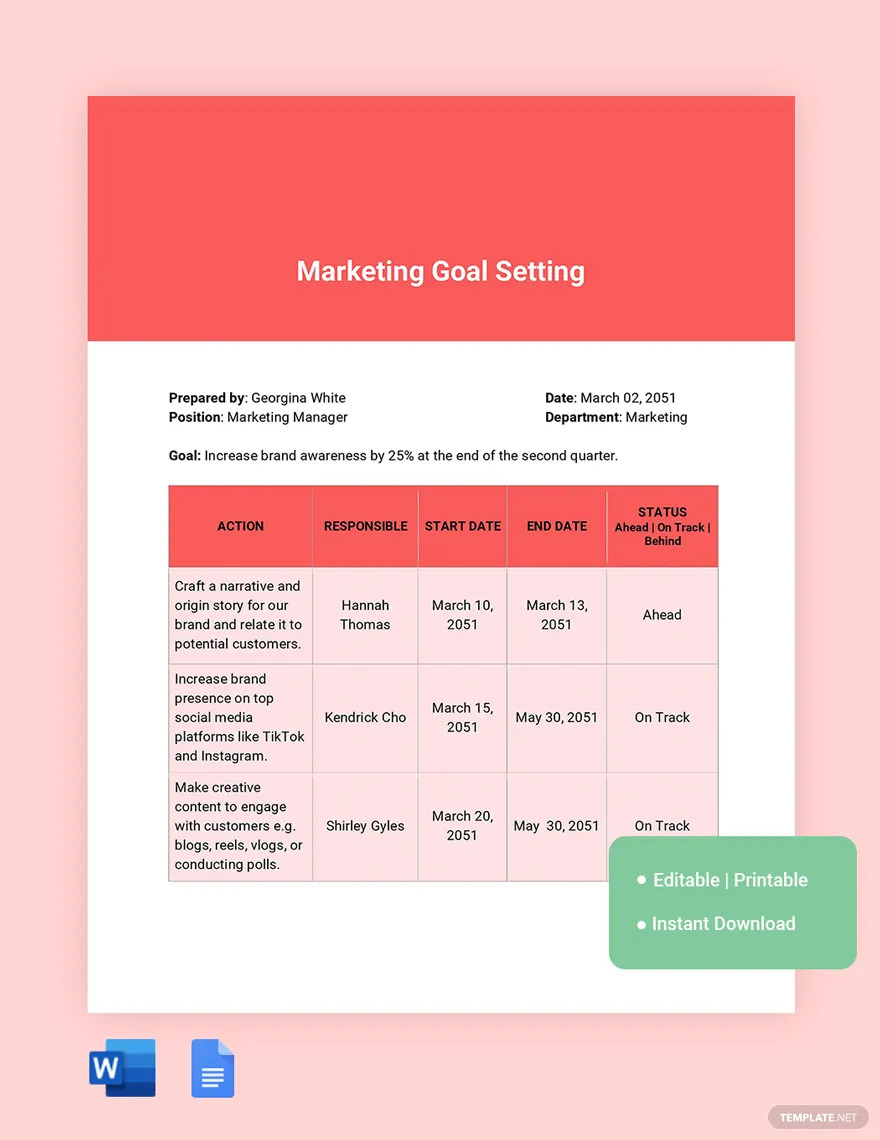
Sales Goal Setting
Just like marketing, the sales industry is broad and fiercely competitive. Only the innovative and committed ones truly succeed in sales. This sales goal setting template can help you redirect your focus and plan out your strategies and initiatives in a more efficient manner.

Personal Goal Setting
When it comes to personal goal setting, self-awareness and dedication are key factors. It is perfectly fine to dream big, but make sure your personal goals are attainable and concrete and not merely some abstract idea. The example below offers a basic template or format for you to start planning and implementing your goals.

Corporate Goal Setting
In any corporate environment, setting targets or goals is essentially second nature. Corporate goal setting involves a highly methodical process that requires the cooperation of everyone in the organization. The corporate goal setting template below is an excellent planning tool that can help you get started on your own organizational goals.

Work Goal Setting
Most people want to achieve something in their line of work. Whether it is a coveted promotion, a salary raise, or better work performance or output, it is necessary for workers to set goals in order to achieve greater clarity and direction. Work goal setting involves a lot of reflection and introspection; thus, it is also important to be honest and open about your own strengths and weaknesses.

Business Goal Setting
Regardless of the nature of the business, it is crucial to invest time and effort into business goal setting. Doing so can help map out the business’ next steps and subsequent action plans. When mapping out your business goals, keep in mind that there must be a timeline and a monitoring mechanism to ensure that your goals are met.
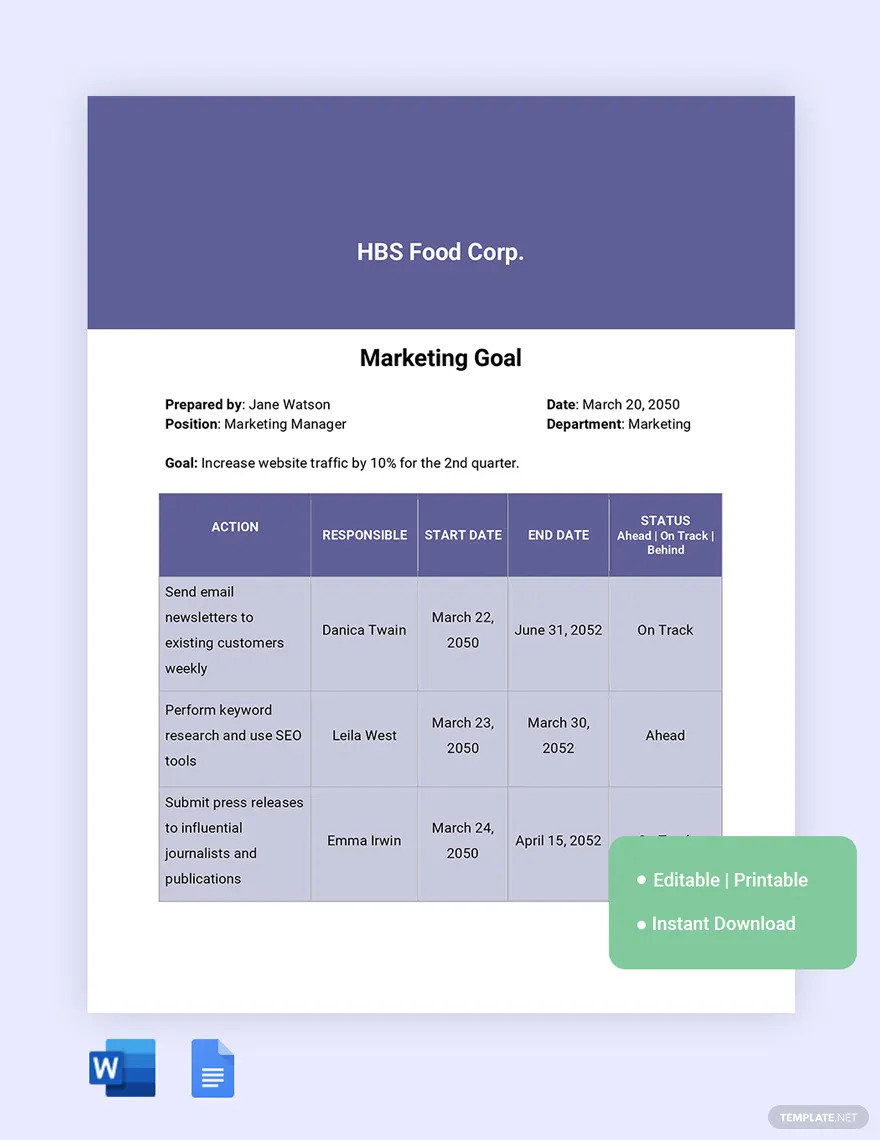
Company Goal Setting
Similar to business and corporate goal setting, company goal setting demands the same amount of commitment and effort. It is important for company goals to be action-oriented, meaning there needs to be concrete and actionable items present in the plan. Use the example below as a blueprint for crafting your own company goal setting plan; simply edit and customize it according to your organizational needs.
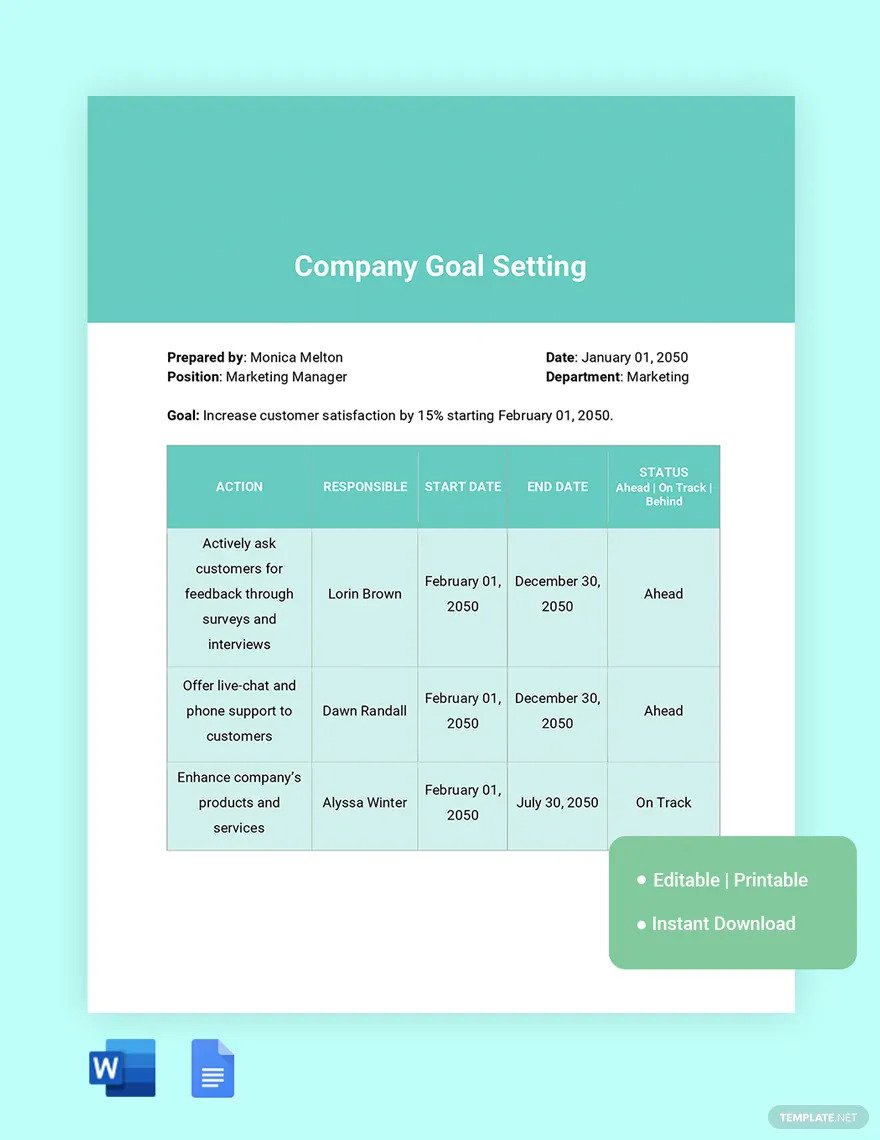
Weekly Goal Setting
An important element in goal setting is a sense of time. When it comes to goals, there is usually a start and an end. For weekly goal setting plans, like the example below, you can include a target accomplishment date along with your tasks and reminders.
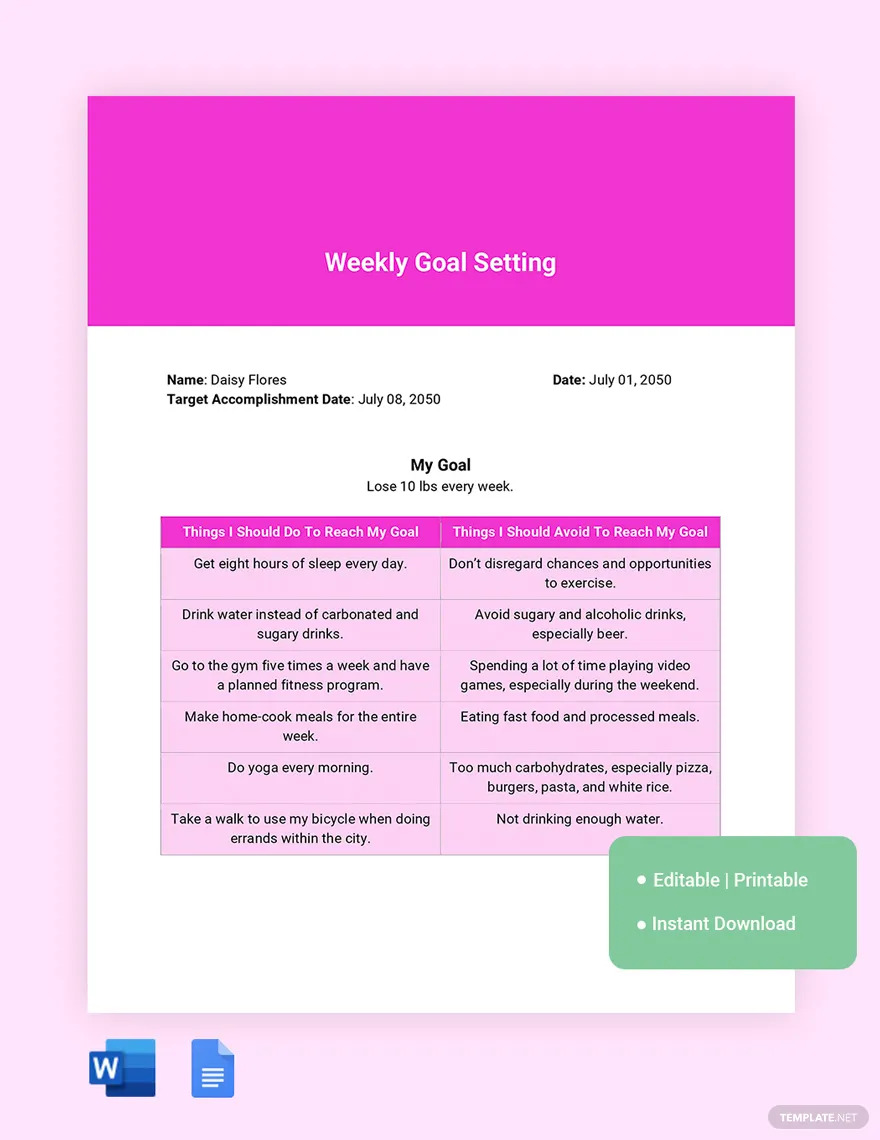
SMART Goal Setting
The best criteria to use in order to know if you’re doing your goal setting correctly is to ask whether or not they are SMART goals. The acronym stands for specific, measurable, achievable, relevant and time-bound. SMART goal setting is the key and if your goal meets all five criteria, then you are in a much better position to realize them.
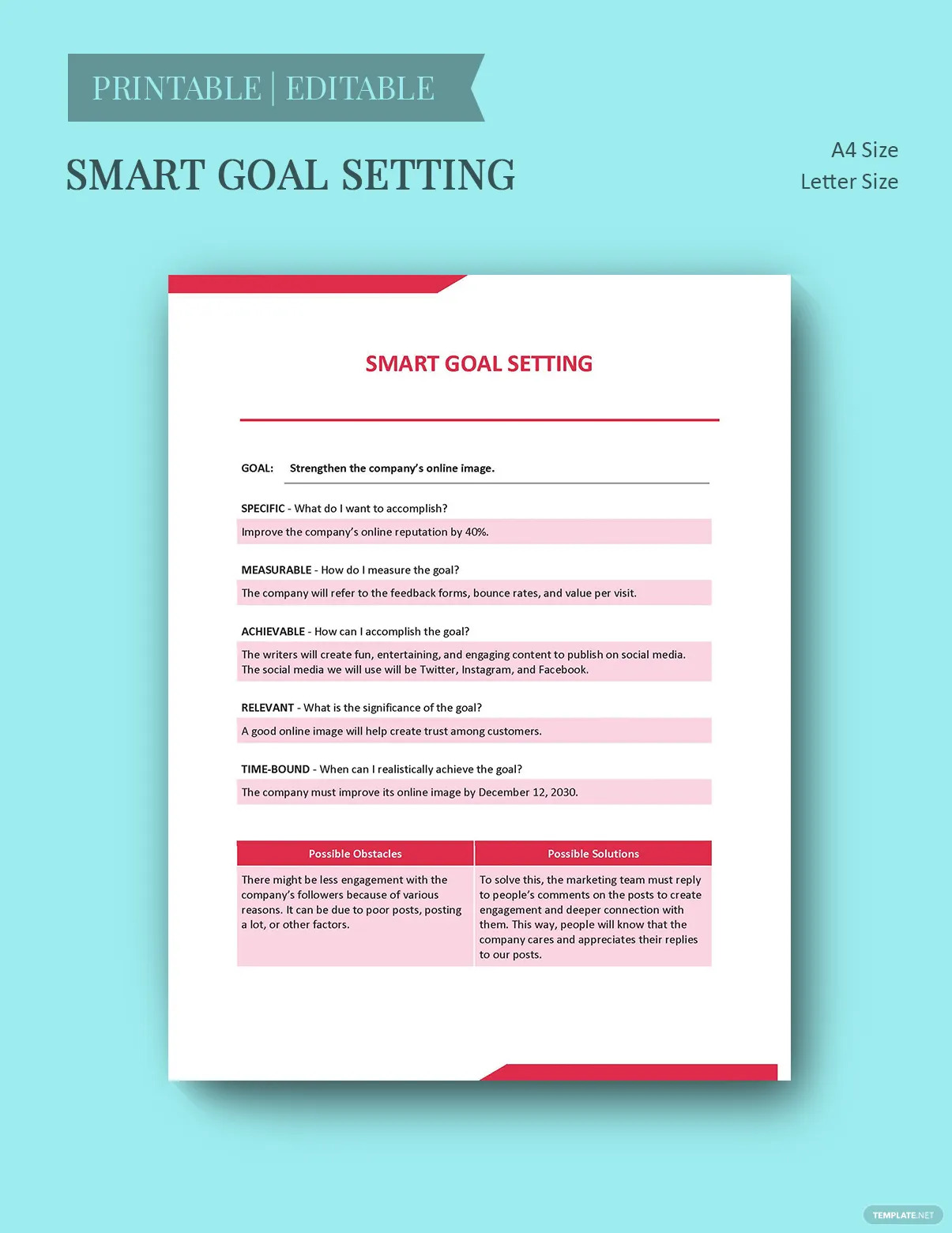
Small Business Goal Setting
Starting and operating a small business can be tough. Whether you are an up-and-coming tech startup or a small neighborhood retail store, you need to be able to establish clear and realistic goals so you can better manage your expectations. The small business goal setting template below comes with an action item column, a status update section and other relevant columns.

Goal Setting Uses, Purpose, Importance
As discussed above, goal setting can serve several purposes. Whether it is for personal or professional reasons, the following are compelling reasons why goal setting is important and useful.
Provides a Clear Direction
The process of setting goals can provide a clear roadmap as to where you are headed. When there is clear direction, you can plan out your next steps better. Having a clear goal can benefit almost anyone- especially students and employees.
Gives a Sense of Purpose
Having goals can give you a deep sense of purpose. Even if it is just short-term goals, people are more likely to remain committed or focused if they know their purpose. Having a sense of purpose is powerful and can compel an individual to act, decide, and move forward.
Source of Motivation
Having a goal in front of you can serve as a powerful motivator. And once you can see your action plan clearly all mapped out, you can be even more motivated to reach your goal. But it is important to note that motivation needs to be sustained and nurtured; thus, a deep sense of purpose and commitment should accompany your motivation.
Helps Prioritize the Important Things
Goal setting is a methodical process that can enable you to prioritize what is important. If you have multiple goals, it can sometimes be difficult to juggle it all. But if you conduct goal setting in the right way, the process allows you to practice prioritization of your goals.
Provides a Sense of Accomplishment
Goal setting has the potential to provide a sense of accomplishment. Especially when you meet a goal or obtain the results you want, the proud sense of accomplishment gives off a positive feeling and it could motivate you even more to continue on. Getting over a hurdle, overcoming an obstacle, or accomplishing a goal is not only satisfying but it helps build one’s confidence as well.
Goal Monitoring
Ideally, goal setting should not just be a one-time event. Goal setting is designed to be monitored and followed through. There may be some instances where you lose track of your goals or veer off the path, but you can always refer to your goal action plan, modify it if needed, then pick up where you left off.
What’s In A Goal Setting Plan? Parts?
Goals or Objectives
To begin goal setting, you need to establish the basics first. Make sure to include your name and the date and enumerate your specific goals. For professional or organizational goal setting, you can include the author’s designation and department.
Action Plan
The process of goal setting always demands a plan of action. If you want a more organized document, you can arrange your action items individually in a table or column.
Timeline
Beside each action item or step, assign a start and end date for accomplishing the task or goal. Including a timeline in your goal setting plan is critical because it helps ensure goal implementation and execution.
Status Remark
In addition to timelines and action plans, you should also include a status column. It is important to have a monitoring mechanism in place so you’ll be able to determine if a task is still pending or in progress, or if you can already proceed to the next action step.
Person-in-Charge
If you want exact accountability, especially for business and team goal setting, you can include an additional column indicating the person assigned to the task or goal. This is also particularly helpful when you have clarifications or questions about specific objectives because then you will know who to address.
How To Design a Goal Setting Plan?
1. Choose a goal setting size
2. Decide the purpose of the goal setting
3. Select a goal setting template that suits your needs
4. Fill in the basic information
5. List down and specify the goals
6. Edit the action steps and assign a corresponding timeline for each step
Goal Setting vs. Motivation
Goal setting is the process of creating, monitoring and executing goals for the purpose of achieving a desired end or outcome.
Motivation is a key ingredient in goal setting and implementation and it is the reason for doing something (e.g., working towards a goal).
What Is The Difference Between Goal Setting, SMART Goal, and a Worksheet?
Goal setting is a process that involves careful planning and strategizing in order to attain specific goals and objectives.
A SMART goal is a goal that is specific, measurable, achievable, relevant and time-bound.
A worksheet is a document that people are supposed to answer or work on; and it may or may not contain specific instructions or guidelines.
Goal Setting Sizes
When crafting or planning out your goals, it is important to establish the proper format. These goal setting sizes are the most common and widely-used sizes for any type of goal plan.
- Letter (8.5 × 11 Inches)
- A4 (8.3 × 11.7 Inches)
Goal Setting Ideas & Examples
Whether you are a fitness trainer, accountant, or even middle school student, goal setting can benefit you in so many ways. You can check out these goal setting ideas and examples to start your own goal setting plan today!
- Sales Goal Setting Ideas and Examples
- Real Estate Goal Setting Ideas and Examples
- OKR Goal Setting Ideas and Examples
- Life Goal Goal Setting Ideas and Examples
- Quarterly Goal Setting Ideas and Examples
- Department Goal Setting Ideas and Examples
- Career Goal Setting Ideas and Examples
- Academic Goal Setting Ideas and Examples
- Therapy Goal Setting Ideas and Examples
- Annual Goal Setting Ideas and Examples
- Daily Goal Setting Ideas and Examples
FAQs
How do you set goals for your employees?
To set goals for your employees, make sure their individual goals are aligned with the company’s overall goals and direction.
How do you set goals and achieve them?
Set realistic and feasible goals so they are more achievable or attainable.
How does effective goal-setting motivate employees?
Effective goal setting can help motivate employees by keeping them focused and enabling them to prioritize the most important goals.
How to Run a Goal-Setting Meeting?
To run a goal setting meeting, invite every team member to share their ideas or insights so as to keep everyone aligned with both individual and team goals.
What is personal Goal Setting?
Personal goal setting is the process of coming up with personal goals and objectives then crafting a plan of action on how to attain them.
How do you create a career goal setting?
To create a goal setting plan for your career, you need to assess your current professional situation then envision your career in the future so as to establish concrete goals with a corresponding timeline.
What is goal setting in business?
Goal setting in business is simply establishing concrete and specific business goals followed by a detailed plan of action to reach these business goals.
What are the 5 steps in goal setting?
Identify the objectives or goals, create actionable steps, assign the person responsible, set a timeline, and stick to the goal.
Why is goal setting important in organizations?
Goal setting is important in organizations because they help direct, manage, and align organizational expectations.
What are the 5 successful principles of goal setting?
The five successful principles of goal setting include clarity of the goal, commitment to the goal, feedback, challenge, and task complexity.
What does goal setting mean?
Goal setting is the process of formulating a concrete plan or steps to achieve a certain goal and it entails identifying specific goals then acting on them accordingly.
What are the three types of goals?
According to Eastern Washington University, there are three types of goals namely process goals, performance goals, and outcome goals.

